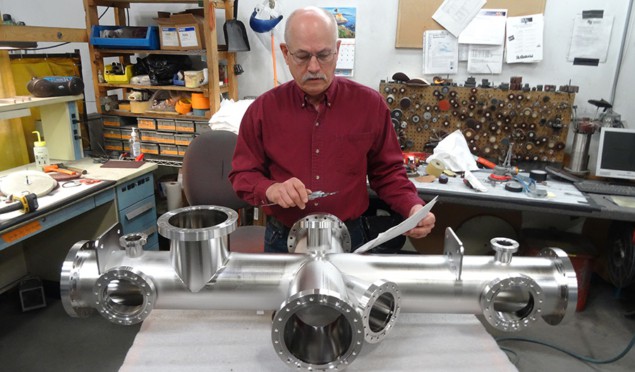Over three decades, Applied Vacuum Technologies (AVT) has developed a wealth of experience in providing custom ultrahigh-vacuum solutions to world-class manufacturers, national labs, universities and research groups. The story behind the company’s growth provides useful insight into what’s needed to cement a strong reputation and to win the trust of customers looking for affordable and robust designs. There are lessons too for physicists keen to broaden their skill set and experience business success, as we follow the rise of AVT with Dan Korolchuk – a vacuum industry veteran who has played a key role in expanding the company.

AVT was founded in 1989 by Jerry Bohn, previously director of Perkin Elmer’s Vacuum Products Division, who was keen to start his own business and saw the opportunity as Perkin Elmer entered a restructuring phase. Despite leaving the corporation, Bohn remained a key element of its operation, with AVT supplying vacuum parts and other hardware to Physical Electronics (PHI) – a leading maker of surface analysis equipment that was owned by Perkin Elmer at the time.
Under Bohn’s leadership, AVT’s operation grew from supplying flanges to building chambers and premium products for users of ultrahigh vacuum (UHV). The company also supplied several small ion pumps for government projects, recalls Dan Korolchuk, who was a manager at PHI during that period, and had known Bohn since the Perkin Elmer days.
The next step for AVT was to tackle bigger projects, which would mean expanding its relatively small team. Unfortunately, 10 years on from starting the firm, Bohn faced health issues that led him to sell the business, and he convinced Korolchuk to buy AVT to safeguard its operation. Thankfully, Bohn recovered after his surgery.
Background in physics
Keen to show that AVT was in safe hands and excited by the opportunities ahead, Korolchuk moved fast to develop the business. “Within eight years we had a new building and more than 50 employees. I took pains to differentiate AVT from other vacuum suppliers because of my background in physics,” he says. “Any supplier can read and accurately interpret a customer’s engineering drawings, whereas I sought to understand the customer’s technology and carry that information back to my production staff.”
I sought to understand the customer’s technology and carry that information back to my production staff
His strategy attracted manufacturers of molecular beam epitaxy (MBE) equipment as well as other new customers requiring vacuum knowledge. By understanding more about a client’s technology, AVT could advise on how various processing steps could enhance or hinder a customer’s efforts.
Working with different sized companies – from start-ups with minimal engineering staff to vertically integrated operations with large technical teams – brought a wide range of requests. This included everything from full design solutions to help with vacuum-specific issues.
AVT’s strong reputation was a major asset across the whole spectrum of services that it offered, helping to ease customer concerns ahead of a project. “Developers want to be sure you understand what they need without divulging any secrets or too much detail,” Korolchuk explains. “They want some assurances that you won’t inject variables into their efforts.”
Understanding client needs
For business relationships to flourish, clients need to feel that their projects are in safe hands. Knowing how to construct and clean chambers to avoid real or virtual leaks may seem like basic vacuum-fabrication skills, but they are extremely important parts of the service. Focusing on reliability upfront ensures that equipment builders and research organizations don’t waste effort chasing down problems further down the line.
There are other aspects too that are important for clients, which is why Korolchuk and his team were proactive in making use of the latest information technology. “Thanks to a state-of-the-art enterprise resource planning system, we were able to give customers real-time status on their orders,” he said. “We knew where everything was at any time and the software could project completion times based on the activities competing for resources on the shop floor.”
The set-up’s cost-estimating feature, which was customized for AVT’s products and shop configuration, made sure that pricing was fast, easy and accurate. Advances in computing also pushed AVT’s technical capabilities to new levels as the team integrated the latest modelling and simulation packages into its workflow.
At the same time, the firm purchased new hardware such as a high-performance co-ordinate-measuring machine. Capable of measuring the machined surfaces of a product within an eight-foot diameter sphere, the tool automatically checked that all critical dimensions were within specified tolerances – a common customer request.
Finding the right solution
These developments helped to open the door to a range of exciting projects. Korolchuk recalls developing hardware to suit a miniature medical device for treating tumours, as well as building massive chambers for use at Sandia National Laboratories.

Customer orders presented AVT with a variety of challenges to overcome. Makers of surface analytical instruments are concerned with precision alignment, which must be maintained even for complex welded parts. Providers of MBE systems and other deposition equipment must preserve clean surfaces and support high-temperature operation. There were other considerations too.
“We built several generations of a product that used a vacuum-generated plasma to sterilize surgical instruments,” Korolchuk remembers. “The device needed to be portable and the customer used AVT expertise for exploring ways to reduce weight while keeping a UHV environment.”
Useful skills for the job
Reflecting on his tenure at the firm, Korolchuk has some sound advice for physicists who aspire to build their own companies. “It’s very easy to become absorbed in the technology and forget there is a business to run – you need resources to support that technology,” he points out.
One of the most important skills, according to Korolchuk, is listening. “Listen to your customers, employees and suppliers,” he advises. Indeed, one of AVT’s key strengths is its ability to partner with clients to deliver the most appropriate solution for each application.
Enhanced operation
In 2013 AVT was acquired by Anderson Dahlen, one of the premier stainless steel and speciality alloy fabricators in the US, and Korolchuk was retained as a consultant during the transition. David Knoll became president of the new company and assumed management of all operations at AVT’s facility in Waconia, Minnesota. Perry Henderson joined AVT to direct the sales and marketing efforts, and a series of investments in personnel, equipment and the facility layout helped to streamline operations and add capacity for growth.
Over the past several years AVT has expanded and enhanced its operation in numerous areas, and now boasts a wider range of customers and applications, additional engineers and project managers, upgraded equipment, and improved capabilities in machining, welding and assembly. The company also worked to develop a vacuum group at Anderson Dahlen’s primary manufacturing facility to take on large-scale projects and chambers that require pressure as well as vacuum. These investments in have resulted in nearly 300% growth of vacuum products for the company since the acquisition.
Today, development of the Applied Vacuum Division continues as the company builds on its strong links with physics and material science research. In 2018 Anderson Dahlen announced further expansions in its vacuum capabilities to take on XHV applications, clean-room assembly and testing, as well as custom-designed vacuum-research equipment.




